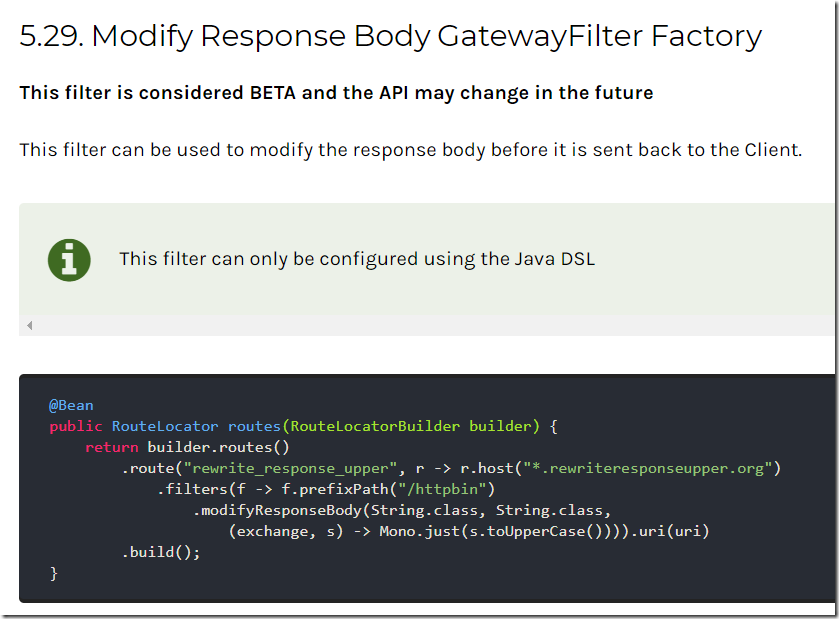网关发起请求后,微服务返回的response的值要经过网关才发给客户端。本文主要讲解在spring cloud gateway 的过滤器中获取微服务的返回值,因为很多情况我们需要对这个返回进行处理。网上有很多例子,但是都没有解决我的实际问题,最后研究了下源码找到了解决方案。
本节内容主要从如下几个方面讲解,首先需要了解我的博文的内容:API网关spring cloud gateway和负载均衡框架ribbon实战 和 spring cloud gateway自定义过滤器 本文也将根据上面两个项目的代码进行扩展。代码见spring-cloud 。
- 新增一个rest接口:我们在三个服务提供者(provider1001、provider1002、provider1003)里面新建一个查询人群信息接口。
本次代码:spring cloud gateway获取response body
一:新增一个rest接口
1,首先在github上面把spring-cloud 克隆到本地。启动三个服务提供者,再启动网关,通过网关能正常访问服务,然后再根据下面的代码进行本节课的学学习。
注意:
- gateway配置文件的 - Auth 最好注释起来,除非使用postman把认证信息传进去,可以参考本节开头提到的两篇博客进行操作。
2,新建一个rest接口,返回大量的数据
注意三个provider里面都要添加一个这样的类,内容
package com.yefengyu.cloud.controller; import org.springframework.web.bind.annotation.GetMapping; import org.springframework.web.bind.annotation.RestController; import java.util.ArrayList; import java.util.List; @RestController public class PersonController { @GetMapping("/persons") public List<Person> listPerson(){ List<Person> personList = new ArrayList<>(); for(int i = 0; i < 100; i++){ Person person = new Person(); person.setId(i); person.setName("王五" + i); person.setAddress("北京" + i); personList.add(person); } return personList; } public static class Person{ private Integer id; private String name; private String address; public Integer getId() { return id; } public void setId(Integer id) { this.id = id; } public String getName() { return name; } public void setName(String name) { this.name = name; } public String getAddress() { return address; } public void setAddress(String address) { this.address = address; } @Override public String toString() { return "Person{" + "id=" + id + ", name='" + name + '\'' + ", address='" + address + '\'' + '}'; } } }
一模一样,无需区分是哪个provider 返回的,本节重点不是负载均衡。然后先重启三个provider,再重启gateway,通过gateway访问这个接口。在浏览器输入http://localhost:8080/gateway/persons就可以看到结果输出。
至此我们在原有的微服务上面增加了一个接口,并且通过网关能正常访问。
二:需求
现在我们需要新建一个局部或者全局过滤器,在过滤器中获取微服务返回的body。在网上查询的时候,发现很多博文都没有讲清楚,主要体现在以下几点:
- 报文可以在网关的过滤器中获取,但是没有返回到客户端
- 报文体太长,导致返回客户端的报文不全
- 中文乱码
我根据很多博文中的内容进行测试,都无法满足我的需求。于是看了官网的5.29节:说明只可以通过 配置类 的方式来获取返回的body内容。

第一小节我们启动了三个 provider和gateway进行测试,现在为了测试配置类这中形式,我们只启动上面的一个provider1001,然后新建一个简单的gateway,注意此gateway代码我不会上传到GitHub,只是验证官网给的例子是正确的。
1、新建一个工程gateway,添加依赖如下:
<?xml version="1.0" encoding="UTF-8"?> <project xmlns="http://maven.apache.org/POM/4.0.0" xmlns:xsi="http://www.w3.org/2001/XMLSchema-instance" xsi:schemaLocation="http://maven.apache.org/POM/4.0.0 http://maven.apache.org/xsd/maven-4.0.0.xsd"> <modelVersion>4.0.0</modelVersion> <groupId>com.yefengyu.cloud</groupId> <artifactId>gateway</artifactId> <version>1.0-SNAPSHOT</version>
<dependencies>
<dependency>
<groupId>org.springframework.cloud</groupId>
<artifactId>spring-cloud-starter-gateway</artifactId>
<version>2.1.0.RELEASE</version>
</dependency>
</dependencies>
</project>
2,新建一个启动类GatewayApplication
package com.yefengyu.cloud; import org.springframework.boot.SpringApplication; import org.springframework.boot.autoconfigure.SpringBootApplication; @SpringBootApplication public class GatewayApplication { public static void main(String[] args) { SpringApplication.run(GatewayApplication.class); } }
3,新建一个配置文件application.yml
server: port: 8000 spring: application: name: gateway_server cloud: gateway: default-filters: routes: - id: my_route uri: http://localhost:1001 predicates: - Path=/gateway/** filters: - StripPrefix=1
4、测试:在浏览器访问 http://localhost:8000/gateway/persons 如果可以获取到结果则说明我们通过网关调用到了微服务。
5、使用配置类的形式:我们从官网已经知道,通过配置类的形式可以在代码中获取到返回的body内容。那么我们新建一个配置类:
package com.yefengyu.cloud; import org.springframework.cloud.gateway.route.RouteLocator; import org.springframework.cloud.gateway.route.builder.RouteLocatorBuilder; import org.springframework.context.annotation.Bean; import org.springframework.context.annotation.Configuration; import reactor.core.publisher.Mono; @Configuration public class MyConfig { @Bean public RouteLocator routes(RouteLocatorBuilder builder) { return builder.routes() .route("my_route", r -> r.path("/gateway/**") .filters(f -> f.stripPrefix(1) .modifyResponseBody(String.class, String.class, (exchange, s) -> { //TODO: 此处可以获取返回体的所有信息 System.out.println(s); return Mono.just(s); })).uri("http://localhost:1001")) .build(); } }
特别注意:
- 官网的例子,拷贝过来少了一个括号,在.build的点之前加一个括号,注意对比。
- 官网代码中的host改为了path。
- 对照代码和上面的修改之前的yml文件,可知他们是一一对应的。
6,配置文件需要修改,不需要使用配置文件形式的,只需要配置端口即可
server:
port: 8000
7,测试:访问 http://localhost:8000/gateway/persons ,不仅浏览器可以返回数据,控制台也可以打印数据,也就是说我们在代码中可以获取到完整的body数据了。
三:更进一步
我们一般喜欢使用配置文件的形式,而不是配置类的形式来配置网关,那么怎么实现呢?这次我们抛弃上面临时新建的gateway工程,那只是验证配置类形式来获取body的。下面我们依然使用从GitHub下载的代码,在那里面来研究。三个provider 无需变动,只要启动就好。
我们思考下:为什么使用配置类的形式就能获取到返回body的数据呢?这是因为spring cloud gateway内部已经实现了这个过滤器(ModifyResponseBodyGatewayFilterFactory),我们要做的是模仿他重新写一个。
1,在我们的网关代码中,我们新建一个局部过滤器ResponseBodyGatewayFilterFactory,并把刚才所有的代码拷贝进去:注意不要拷贝包,并且把ModifyResponseBodyGatewayFilterFactory全部替换为ResponseBodyGatewayFilterFactory。
2,去掉代码中的配置类
public class ModifyResponseBodyGatewayFilterFactory extends AbstractGatewayFilterFactory<ModifyResponseBodyGatewayFilterFactory.Config> {
替换为
public class ResponseBodyGatewayFilterFactory extends AbstractGatewayFilterFactory<Object> {
3,删除
public ResponseBodyGatewayFilterFactory() { super(Config.class); } @Deprecated public ResponseBodyGatewayFilterFactory(ServerCodecConfigurer codecConfigurer) { this(); }
4,apply方法更改
@Override public GatewayFilter apply(Config config) { ModifyResponseGatewayFilter gatewayFilter = new ModifyResponseGatewayFilter( config); gatewayFilter.setFactory(this); return gatewayFilter; }
替换为
@Override public GatewayFilter apply(Object config) { return new ModifyResponseGatewayFilter(); }
注意有错误暂时不管。
5,删除静态内部类Config的所有内容,直到下面的ModifyResponseGatewayFilter类定义处。下面我们来操作ModifyResponseGatewayFilter类内部内容。
6,删除
private final Config config; private GatewayFilterFactory<Config> gatewayFilterFactory; public ModifyResponseGatewayFilter(Config config) { this.config = config; }
7,删除
@Override public String toString() { Object obj = (this.gatewayFilterFactory != null) ? this.gatewayFilterFactory : this; return filterToStringCreator(obj) .append("New content type", config.getNewContentType()) .append("In class", config.getInClass()) .append("Out class", config.getOutClass()).toString(); } public void setFactory(GatewayFilterFactory<Config> gatewayFilterFactory) { this.gatewayFilterFactory = gatewayFilterFactory; }
8,删除无效和错误的依赖引入,特别是:
import static org.springframework.cloud.gateway.support.GatewayToStringStyler.filterToStringCreator;
9,此时还有三处报错,都是config对象引起的。第一二处:
Class inClass = config.getInClass();
Class outClass = config.getOutClass();
改为:
Class inClass = String.class; Class outClass = String.class;
第三处:
Mono modifiedBody = clientResponse.bodyToMono(inClass) .flatMap(originalBody -> config.rewriteFunction .apply(exchange, originalBody));
这里最为重要,是我们获取返回报文的地方。改为:
Mono modifiedBody = clientResponse.bodyToMono(inClass) .flatMap(originalBody -> { //TODO:此次可以对返回的body进行操作 System.out.println(originalBody); return Mono.just(originalBody); });
10,配置文件增加这个局部过滤器ResponseBody即可:
filters: - StripPrefix=1 # - Auth - IPForbid=0:0:0:0:0:0:0:1 - ResponseBody
11,将ResponseBodyGatewayFilterFactory注册到容器中,添加一个@Component注解即可。
12,启动网关,访问 http://localhost:8080/gateway/persons ,不仅浏览器可以返回数据,控制台也可以打印数据,也就是说我们在过滤器的代码中可以获取到完整的body数据了。
完整代码如下:
package com.yefengyu.gateway.local; import org.reactivestreams.Publisher; import org.springframework.cloud.gateway.support.CachedBodyOutputMessage; import org.springframework.stereotype.Component; import reactor.core.publisher.Flux; import reactor.core.publisher.Mono; import org.springframework.cloud.gateway.filter.GatewayFilter; import org.springframework.cloud.gateway.filter.GatewayFilterChain; import org.springframework.cloud.gateway.filter.NettyWriteResponseFilter; import org.springframework.cloud.gateway.filter.factory.AbstractGatewayFilterFactory; import org.springframework.cloud.gateway.support.BodyInserterContext; import org.springframework.core.Ordered; import org.springframework.core.io.buffer.DataBuffer; import org.springframework.http.HttpHeaders; import org.springframework.http.server.reactive.ServerHttpResponse; import org.springframework.http.server.reactive.ServerHttpResponseDecorator; import org.springframework.web.reactive.function.BodyInserter; import org.springframework.web.reactive.function.BodyInserters; import org.springframework.web.reactive.function.client.ClientResponse; import org.springframework.web.server.ServerWebExchange; import static org.springframework.cloud.gateway.support.ServerWebExchangeUtils.ORIGINAL_RESPONSE_CONTENT_TYPE_ATTR; @Component public class ResponseBodyGatewayFilterFactory extends AbstractGatewayFilterFactory<Object> { @Override public GatewayFilter apply(Object config) { return new ModifyResponseGatewayFilter(); } public class ModifyResponseGatewayFilter implements GatewayFilter, Ordered { @Override public Mono<Void> filter(ServerWebExchange exchange, GatewayFilterChain chain) { return chain.filter(exchange.mutate().response(decorate(exchange)).build()); } @SuppressWarnings("unchecked") ServerHttpResponse decorate(ServerWebExchange exchange) { return new ServerHttpResponseDecorator(exchange.getResponse()) { @Override public Mono<Void> writeWith(Publisher<? extends DataBuffer> body) { Class inClass = String.class; Class outClass = String.class; String originalResponseContentType = exchange .getAttribute(ORIGINAL_RESPONSE_CONTENT_TYPE_ATTR); HttpHeaders httpHeaders = new HttpHeaders(); httpHeaders.add(HttpHeaders.CONTENT_TYPE, originalResponseContentType); ClientResponse clientResponse = ClientResponse .create(exchange.getResponse().getStatusCode()) .headers(headers -> headers.putAll(httpHeaders)) .body(Flux.from(body)).build(); Mono modifiedBody = clientResponse.bodyToMono(inClass) .flatMap(originalBody -> { //TODO:此次可以对返回的body进行操作 System.out.println(originalBody); return Mono.just(originalBody); }); BodyInserter bodyInserter = BodyInserters.fromPublisher(modifiedBody, outClass); CachedBodyOutputMessage outputMessage = new CachedBodyOutputMessage( exchange, exchange.getResponse().getHeaders()); return bodyInserter.insert(outputMessage, new BodyInserterContext()) .then(Mono.defer(() -> { Flux<DataBuffer> messageBody = outputMessage.getBody(); HttpHeaders headers = getDelegate().getHeaders(); if (!headers.containsKey(HttpHeaders.TRANSFER_ENCODING)) { messageBody = messageBody.doOnNext(data -> headers .setContentLength(data.readableByteCount())); } return getDelegate().writeWith(messageBody); })); } @Override public Mono<Void> writeAndFlushWith( Publisher<? extends Publisher<? extends DataBuffer>> body) { return writeWith(Flux.from(body).flatMapSequential(p -> p)); } }; } @Override public int getOrder() { return NettyWriteResponseFilter.WRITE_RESPONSE_FILTER_ORDER - 1; } } }